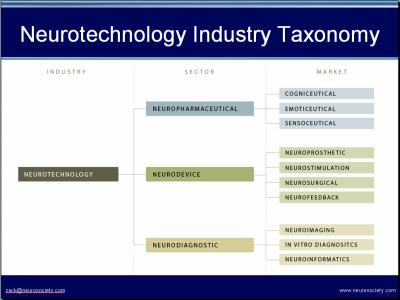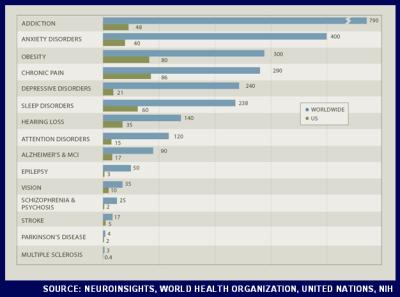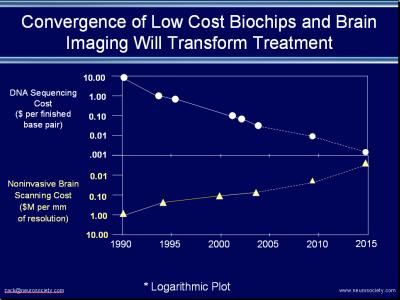Perception Shifting in Neurosociety: Ethical and Societal Implications
Zack Lynch
Page 2 of 5
Today, the neuro technology industry includes companies researching developing pharmaceuticals, biological medical devices, as well as diagnostic and surgical equipment for the treatment of neurological diseases and psychiatric illnesses. There are over 450 public and private companies worldwide which can be categorized into three sectors.

Image 2: Neurotechnology Industry Taxonomy
Neurotechnologies include neuropharmaceuticals [1], which include the widely used drugs for pain; psychosis, epilepsy, et cetera; neuro devices which included successfully established products that we’ve been discussing already today, such as cochlear implants or the deaf which have been implanted in over 80,000 people already; and neuro stimulation devises for the treatment of pain.
There are also emerging neuro-device approaches for the treatment of psychiatric illnesses including vegus nerve stimulation, deep brain stimulation, and, as we just heard, repetitive trans-cranial magnetic stimulation.
The neuro-diagnostic sector is broken into three markets, neuro imaging; in-vitro diagnostics; and neuro-informatics.
The market drivers here are of course; rising health care costs; consumer demand for diagnostic information; and the improved need for better information management.
In 2005, neuro technology products worldwide, across these three sectors, generated nearly $111 billion in revenue and grew in double digits. And several factors are driving the development of this industry, including demographic shifts, increasing economic burden, accelerating intellectual property creation, and a push for personalized treatment.

Image 3: Brain-related Illnesses; World / U.S.
Today, over 1.5 billion people worldwide suffer from some sort of brain related illness. That’s one of every four people is directly impacted by some sort of brain related disease. You can see today incidence number is broken here, addiction, depression, chronic pain, sleep disorders, attention disorders, all the way down to Parkinson’s disease and Multiple Sclerosis. These numbers are increasing as the global population expands and individuals live longer, creating unprecedented demand for treatments that delay, prevent, and cure chronic neurological diseases and psychiatric illnesses.
Of course, beyond the immeasurable human suffering caused by brain illness, there is also substantial, economic impact of brain disorders. A multitude of recent studies have attempted to quantify the economic costs of brain illness.
One recent report estimated the economic cost, including treatment and lost income, at over a trillion dollars, and I would estimate that this is far too low a number. Despite the scope and scale of the problem, there is help in the form of new tools and new technologies. As with previous waves of innovation, emerging technologies are enabling new solutions to what seemed to be insurmountable problems.
Nano-technology is making possible the delivery of complex compounds more easily to the brain. Advances in biotechnology in the areas like stem cells [2] are creating new possibilities for brain regeneration while brain image processing, driven by Moore’s Law [3] like advances, are allowing us to understand the brain and the molecular events that are occurring in real time. While, of course, new techniques in neuroscience are making it possible to characterize the growing number of proteins involved in memory and emotions.
In addition to the development of individual technologies, there are multiple examples of converging technologies; for example, the convergence of biochips and brain imaging technology which will allow us to understand how the brain works from both the inside sub-cellular levels and from the system-wide level. Transforming how we diagnose disease and treat it.

Image 4: Convergence of Low Cost Biochips and Brain Imaging Will Transform Treatment
As we saw this morning the exponential decrease in the cost of processing power is occurring across many sectors of the economy. As this chart plots, in recent years the decreasing cost of biochips has made it possible to characterize a whole new number of your transmitters, receptors, ion channels and other proteins critical for normal brain function. While on the bottom here, we have at the same time higher resolution brain imaging technologies of course, continuously getting cheaper; leading us the time of 2015 when we should be able to start understanding many events in the brain.
Indeed more has been learned in the past five years than over the past fifty years about the brain. But the story doesn’t end there. The same knowledge about how the brain functions will make it possible to enhance the performance of normal brains.
The implications of brain enhancement are profound. It’s important to understand that at least in the next 50 years -- I’m not talking about a future where we can upload and download our brains. Instead, I believe that neurotechnology will provide us tools to temporarily influence parts of our brains to improve the natural processes that already exist. Now that we have solid grounding of where therapeutic neurotechnology stands, we’ll move into the neuro-enhancement discussion. But of course, technological possibilities alone do not drive societies people do.
Footnotes
1. Neuropharmaceuticals - are pharmacological agents whose primary mode of action is through altering the metabolism of neurotransmitters. Clinical analysis usually applies directly to mechanisms of the diseases of the nervous system which will likely then be translated into disease perception, prevention, and curing, such as studies of brain display techniques, trials to test innovative pharmaceuticals, and formation of novel therapies such as stem cell implants and gene transfer.
http://www.neuropharmaceuticals.com/ April 25, 2007 12:58PM EST
2. Stem cells - Research on stem cells is advancing knowledge about how an organism develops from a single cell and how healthy cells replace damaged cells in adult organisms. This promising area of science is also leading scientists to investigate the possibility of cell-based therapies to treat disease, which is often referred to as regenerative or reparative medicine.
http://stemcells.nih.gov/info/basics/basics1.asp April 25, 2007 1:10PM EST
3. Moore’s Law - is the empirical observation made in 1965 that the number of transistors on an circuit for minimum component cost doubles every 24 months. It is attributed to Gordon E. Moore (born 1929), a co-founder of Intel. Although it is sometimes quoted as every 18 months, Intel's official Moore’s Law page, as well as an interview with Gordon Moore himself, state that it is every two years.
http://en.wikipedia.org/wiki/Moore's_law April 25, 2007 1:35PM EST